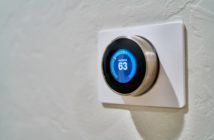Spring is here. Nearly every homeowner is throwing open the windows to let in warm spring breezes. While the idea is good, homeowners should be careful. This habit could carry into summer, when the sun’s rays turn the house into a sauna.
Pretty much everything conducts heat. Put your hand on a car’s door or fender in August. Then touch the sidewalk. Even a tree trunk will be warm. The same conduction is going on in your house. The roof, walls, as well as the windows all conduct the sun’s heat.
I See. Why Is That a Bad Idea?
To understand the answer to that question, you have to know how an air conditioner works. The innards of that huge box in your backyard sucks out the humidity or moisture in your house. Once it’s gone, what is left is cool dry air.
Now imagine you’ve come home to an empty house. The indoor air feels like you’re walking into a wall of water. You obviously turn on the a/c. It takes a while, but finally the air is cool. You’re relieved, until you see the power bill. What on earth happened?
How the Power Bill Works
The air in the a/c blows past freon, which cools. It is blown into the house until it reaches the temperature set by the thermostat. When the temp rises, the a/c blows some more until it reaches the set temperature. On and off, on and off it goes, all while using kilowatt hours on the power meter. Can you see how the power bill is affected by the air conditioning?
How Can I Stop This?
Begin outside the house. Stop the sun’s punishing heat from entering the house. When awnings are installed on windows facing south and west, then the heat of the sun is cut by 77 percent, says energy.gov.
What Is An Awning?
An awning is a cloth roof on an often aluminum frame. The awning’s purpose is to protect from damaging weather whatever is beneath it. Awnings come in fixed or retractable coverings. Retractable coverings are generally found over outdoor living spaces, patios and the like. Fixed covers are usually seen over windows. They mostly shade southern and western-facing windows.
Awnings are made of synthetic materials which are coated to be waterproof. These repel mildew and mold. They come in tightly woven, laminate, as well as mesh materials, wildly colored in varieties of stripes, spots, patterns or solids.
What Impact Do Awnings Have On The Power Bill?
Bob Vila of This Old House tells us that awnings cut the heat hitting windows up to 65 percent in southern windows. In western-facing windows, the number leaps up to 77 percent. He projects that, for the Eastern seaboard, a hot summer can save homeowners with awnings between 27 and 33 percent off their power bills.
Now, let’s say your air conditioner is set at 75 degrees every day. Awnings cut the indoor temperature by 15 degrees. Let’s say you pay, on average, $100 for your power bill. When 77 percent of the sun’s punishing rays are being reflected back off the windows, then you should save $75 off your power bill.
Keep in mind that warm air will cluster beneath the awning. Warm air hitting the windows needs to be vented. Some awnings have eyelet openings on the skirts of the covering to allow for venting. Make sure yours have some method of venting the trapped air.
It’s a scientific fact that heat and cold seek each other through the most direct means. In the case of your house, that means is the windows. Fifty percent of air heated by the sun will get into the house via a window. This makes the a/c work harder, driving the power bill up. Awnings keep this from happening.




